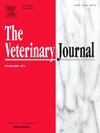Emergence and rapid propagation of ST4 Mycoplasma bovis subtype in France and Belgium
IF 3.1
2区 农林科学
Q1 VETERINARY SCIENCES
引用次数: 0
Abstract
Mycoplasma (M.) bovis is a major pathogen worldwide involved in bovine respiratory disease with significant economic and welfare impacts. Since the 2000s, the laboratory-based surveillance network Vigimyc has integrated molecular typing of an annual subset of M. bovis isolates collected in France, and more recently in Belgium. This study aimed to characterize the epidemiological situation and evolution of M. bovis in both countries over the 2018–2024 period. A total of 498 M. bovis isolates were characterized using a routine monitoring approach based on polC subtyping. We observed the apparent re-emergence and the rapid spread of polC st1 isolates since 2019 in France and 2020 in Belgium, accompanied by a concurrent and marked decline of the previously dominant polC st2 genotype. To investigate this phenomenon, we performed whole-genome sequencing on 45 polC st1 isolates to explore their genetic diversity and evolutionary relationships between strains. Genome-based analyses highlighted that this population was phylogenetically distinct from the older polC st1 isolates collected before 2000 and belonged to the ST4 according to the updated PubMLST database. The genetic diversity within these isolates was extremely low in comparison to that observed in the other subtypes, thus highlighting the recent and clonal emergence of this new lineage. In the absence of apparent AMR switch associated with this expansion, as previously observed for the emergence of polC st2 population, we identified putative genetic patterns specific to this lineage that may contribute to the fitness and epidemiological success of recent polC st1 isolates.
ST4牛支原体亚型在法国和比利时的出现和快速繁殖。
牛支原体(M.)是世界范围内涉及牛呼吸道疾病的主要病原体,具有重大的经济和福利影响。自2000年代以来,以实验室为基础的监测网络Vigimyc整合了在法国和最近在比利时收集的牛分枝杆菌分离物的年度亚群的分子分型。本研究旨在描述2018-2024年两国牛支原体的流行病学状况和演变。总计4.98亿美元。采用基于polC亚型的常规监测方法对牛分离株进行鉴定。我们观察到,自2019年和2020年以来,polC st1分离株在法国和比利时明显重新出现并迅速传播,同时伴随着先前占主导地位的polC st2基因型的显著下降。为了研究这一现象,我们对45株polC st1进行了全基因组测序,以探索其遗传多样性和菌株间的进化关系。基于基因组的分析强调,该群体在系统发育上与2000年之前收集的较早的polC st1分离株不同,根据更新的PubMLST数据库,该群体属于ST4。与在其他亚型中观察到的遗传多样性相比,这些分离株的遗传多样性极低,因此突出了这一新谱系的近期和无性出现。在没有与这种扩展相关的明显AMR开关的情况下,正如之前观察到的polC st2群体的出现,我们确定了该谱系特有的假定遗传模式,这可能有助于最近的polC st1分离株的适应性和流行病学成功。
本文章由计算机程序翻译,如有差异,请以英文原文为准。
求助全文
约1分钟内获得全文
求助全文
来源期刊

Veterinary journal
农林科学-兽医学
CiteScore
4.10
自引率
4.50%
发文量
79
审稿时长
40 days
期刊介绍:
The Veterinary Journal (established 1875) publishes worldwide contributions on all aspects of veterinary science and its related subjects. It provides regular book reviews and a short communications section. The journal regularly commissions topical reviews and commentaries on features of major importance. Research areas include infectious diseases, applied biochemistry, parasitology, endocrinology, microbiology, immunology, pathology, pharmacology, physiology, molecular biology, immunogenetics, surgery, ophthalmology, dermatology and oncology.
 求助内容:
求助内容: 应助结果提醒方式:
应助结果提醒方式:


